Cyclify India is reader-supported! We may receive an associate commission if you make a purchase through one of the Amazon Associate links on this page! Continue Reading…
Difficulty is always there when biking. If you ride a bike often, you are accustomed to sometimes oiling and lubricating your chain. You must follow this basic bicycle maintenance to maintain your bike in good working order.
However, how to remove rust from your bike chain? It could seem strange, particularly when you consider how meticulously you maintain your bike. It may be similarly aggravating, especially because the chemicals never seem to go away, no matter how you clean the rust off the chain.
So, Fortunately, we’ve compiled a list of tried-and-true methods for keeping your bike chain clean & rust-free. All you have to do is check your bike chain, clean it with steel wool and a scouring pad, apply a good degreaser, and then lube.
It can be rather difficult and time-consuming to remove a bike chain for cleaning. When eliminating rust, it is considerably simpler to leave the chain in place.
I’ll walk you through each of these three processes in-depth in this post so you can do this procedure correctly every time. I’ll also cover all the information you want, which comprises:
Read this entire guide through to the end to learn all the steps.
Table of Contents
Why is My Bike Chain Rusting?
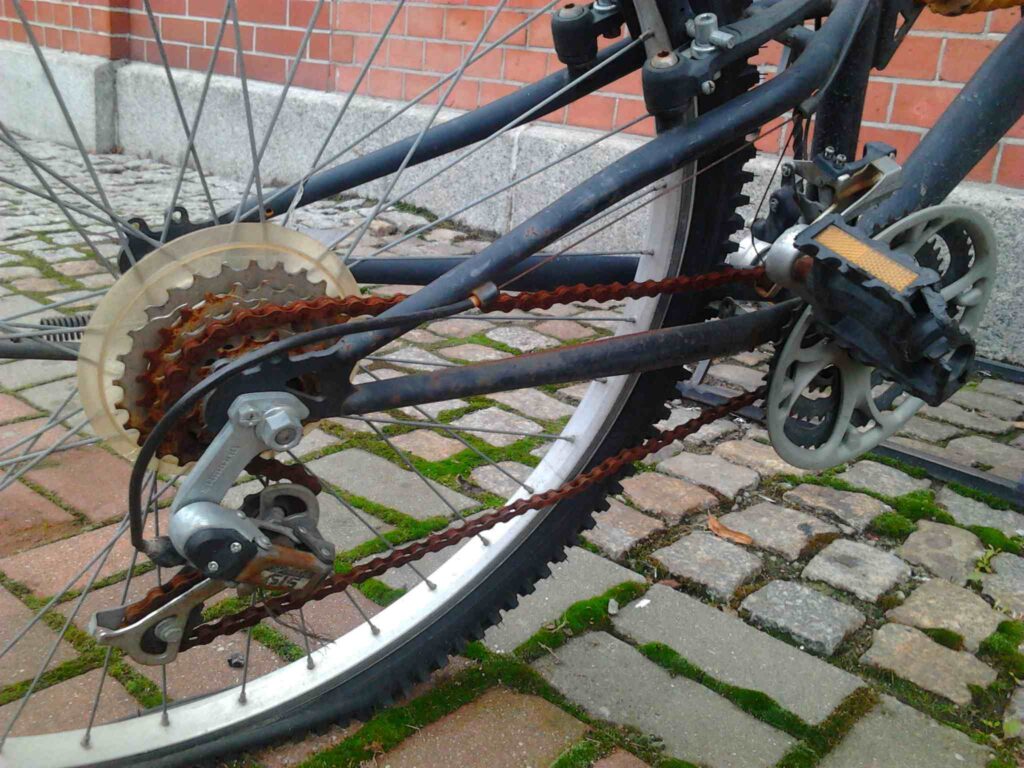
The following issues might cause your bicycle chain to rust:
1. Lubing your chain too much:
There needs to be equilibrium when it comes to lubricating your chain. Your drive train will suffer greatly if there is no lubrication at all in your chain. However, over-lubricating your chain can draw more dirt and grime, which will wear it down more quickly in the long run.
2. Not washing your bicycle after a ride
The majority of us are accustomed to riding our bikes home and taking a shower right after. We often forget that giving your bike, particularly the drive train, a thorough cleaning will help extend both of their lifespans.
3. A Rainy Day:
Riding a bike in the rain is enjoyable, but the experience is diminished if the bike is left to dry without being cleaned. Rainwater & salts can cause rust on your bicycle, which can be detrimental over time.
4. Keeping your chain the same:
Because they are ignorant, novice riders frequently make this error. Riding till there’s no tomorrow is common. Over time, both the chain and the cassette will eventually wear totally out and require replacement.
Why Rust is Bad for your Bike Chain?
Bike chains are particularly vulnerable to rust. It is possible for metal to rust and corrode when it is exposed to oxygen & moisture for too long.
Bicycles and riders alike may experience various issues as a result of a rusty chain. The following are some explanations for why rust harms your bike chain:
1. Creates Friction
Rough spots on a bike chain cause friction between the links, which makes pedaling more challenging.
Especially if you’re riding uphill or over tough terrain, this might make your journey less efficient as well as more challenging.
Moreover, the higher friction wears down the chain more, which increases the risk of rust along with other issues.
2. Your Gears Get Damaged
A rusty bike chain can damage other parts of the bike, such the gears, when it comes into contact with them.
Your bicycle’s gears can break or wear down more quickly if rust particles from the chain become lodged in them. You could be left stuck without access to transportation if something needs to be repaired, which might be expensive.
3. Reduces Your Chain’s Life
A chain that has been well-maintained will outlast one that has been rusted. Rust eats away at the metal and eventually causes it to corrode and weaken, which in turn causes the chain to become brittle and break.
If this problem arises while you’re riding, it might be dangerous, and replacing the chain could be costly.
4. It may be hard to clean
Removing rust from a bike chain can be challenging, particularly if it has been present for a long time. To remove it, specialized equipment and chemicals will be needed.
Furthermore, it might worsen the chain’s harm if done incorrectly.
After discussing the reasons why rust may be detrimental to your bike chain, let’s move on to the instructions for cleaning your chain.
Equipment and Supplies You’ll Require
First, everything that you’ll require for dealing with the rust on your bike is listed below:
1. Lubricant for the Chain
Any rust particles that have adhered to your chain may be removed with the use of a chain lubricant. For this, use a degreaser or specialty chain lubricant.
2. A Brush
To remove the rust particles off your chain, you’ll need a brush. You can use a chain cleaning brush or a toothbrush with hard bristles.
3. A cloth or rag
To remove any extra lubricant or rust particles that come off your chain throughout the operation, you’ll need one of these.
4. A Cleansing Agent
To clean your chain, you can use a mild dish soap or a specific bike cleaning solution. Before using the cleaning solution, don’t forget to dilute it with water.
5. Hand Covers or Gloves
It’s imperative that you wear gloves during the cleaning procedure to shield your hands from any chemicals or lubricants.
Bike rack or work stand?
It is strongly advised that you use the stand or rack to hold your bike steady as you clean the chain. This will facilitate a complete and uniform cleaning of the chain.
(Pro tip: Always use high-quality solutions available on the market to remove rust effortlessly. The majority of steel wools use sturdy materials that remove dust quickly and effectively.)
Read More: How to Clean your Bicycle Chain with Household Products?
How to Remove Rust from your Bike Chain: Step-by-Step Guide

Naturally, you must get the necessary tools to be ready for this maintenance task before starting. Which we’ve already covered above
After assembling the necessary equipment, you may now do the following:
Step 1: Check the chain on your bicycle
Of course, to determine the location of the rust build-up, you must perform a comprehensive inspection of your bike chain. Only a part of your bike chain is eaten by rust, not the entire chain. You must thus locate the spot where the rust first emerges.
It is advised to flip your bike over or secure it to a bike stand or rack in order to have a closer look at your chain. You can hook your bike on the wall if you don’t have a bike stand. When checking the bike chain, it is important that your bike be resting on a stable surface.
At this point, you can look along the whole chain for rust as well as dirt. The chain must be carefully inspected in order to identify which parts require meticulous cleaning and rust scrubbing.
Step 2: Examine the chain’s condition
The next step is to assess the chain’s general state. To get the rust off the chain, it will assist you in determining how much cleaning and maintenance you need to do. You can determine if you need to replace your chain or whether it merely needs to be cleaned and lubricated based on the amount of rust that has been collected.
To determine how much the chain’s color has changed, you must examine it closely. Your understanding of the state of the entire chain will improve as a result. Replacing the chain is the recommended course of action if you notice any warping, flaws, inconsistent color, or metal corrosion.
To restore the chain’s original appearance, however, a property cleaning & oiling are necessary if there is just surface rust & crustiness.
Step 3: Take the chain off before you clean.
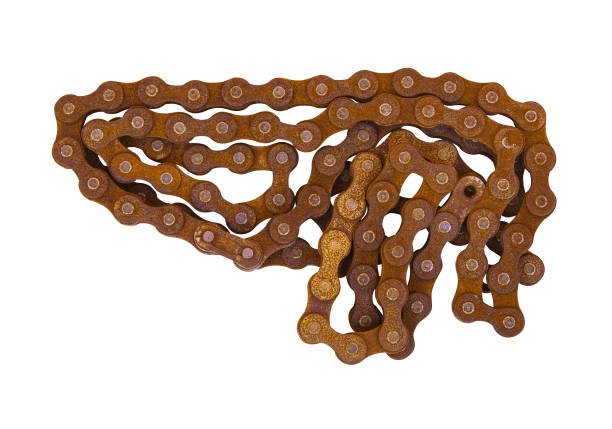
You must remove the chain from the bike in order to clean it correctly. Finding the master link is the first step in conveniently removing the chain from the bike. In contrast to the other chain links, the master link has a unique appearance.
Disconnect the master link from the remainder of the chain as soon as you’ve located it. After that, remove your bike’s whole chain.
(Expert advice: Make sure the chain is always fully removed from the bike. It will allow you to see just how much rust has developed. Additionally, you’ll be able to clean the bike from all sides.
Step 4: Rust removal from the surface
You can see the bike chain more clearly now that the chain has been fully removed from your bicycle. Now that the rust is visible up close, you can decide which region needs cleaning first.
To start, you can wriggle the chain to clear it of extraneous particles and grime. Next, wipe the rust off with a piece of cloth at first. You’ve removed all of the surface rust off your chain by now.
Step 5: Apply a degreaser and a scouring pad
To get rid of further rust buildup on the chain after the first cleaning, you can use a degreaser & scouring pad. To remove rust from the chain, use a clean rag or scouring pad dampened with a degreaser plus a little effort.
There is rust that is still there after the first cleaning that is difficult to eliminate. Therefore, you must alter your strategy. This time, start using a toothbrush with firm bristles. Additionally, use forceful scrubbing or polishing to get rid of tough rust.
Read More: How to Make a Degreaser at Home for Cleaning Bike’s Chain?
Step 6: Spend a few minutes soaking the chain in degreaser and thick filth.
Naturally, the chain will still have some rust on it. You must soak the chain in a degreaser or heavy grime in order to be able to clean it and shatter the particles that are causing the rust. Give the chain around 20 minutes to steep in the degreaser.
Following that, you may now use hot water to rinse the chain. The degreaser will be greatly removed from the chain by the water.
(Pro tip: You may wriggle the chain to shake off any extraneous particles while it’s soaking. When doing this step, make sure you are wearing protective gloves.
Step 7: Keep using harsh brushes and steel wool to clean the chain.
Apply steel wool & lime juice to the chain, being sure to completely clean the rusty areas. You must wear gloves for this stage in order to shield your hands from dangerous materials. You may use lime juice to moisten the steel wool and scrub it firmly on the rusted areas to increase the efficacy of this procedure.
The remaining rust and grime can then be removed using a paper towel or dry cloth. This procedure should be repeated until the rust starts to disappear.
Step 8: Use WD-40 to break up strong, resistant rust.

Your bike chain is now returning to its natural shape at this stage. But, the chain may still have strong, unyielding rust on it. This can be broken apart with a WD-40 spray. Apply the material immediately to the rusted area, then wait a few minutes for the chemical to settle before cleaning it away.
After that, you may clean the chain once again and give the corroded region extra pressure. Lastly, use a dry towel to wipe down the entire chain.
Step 9: Adjust the Bicycle Chain.
I hope this article will help you with bike maintenance and cleaning. We make sure the procedures are comprehensive, simple to follow, and efficient in removing rust from your bike.
Next, we would love to hear your ideas, if you have any. Please feel free to leave a comment below if you would want further information or recommendations. Additionally, you are more than welcome to like and share this post if you find it helpful.
How to Clean the Rust Without Removing Bike Chain: Comprehensive Guide
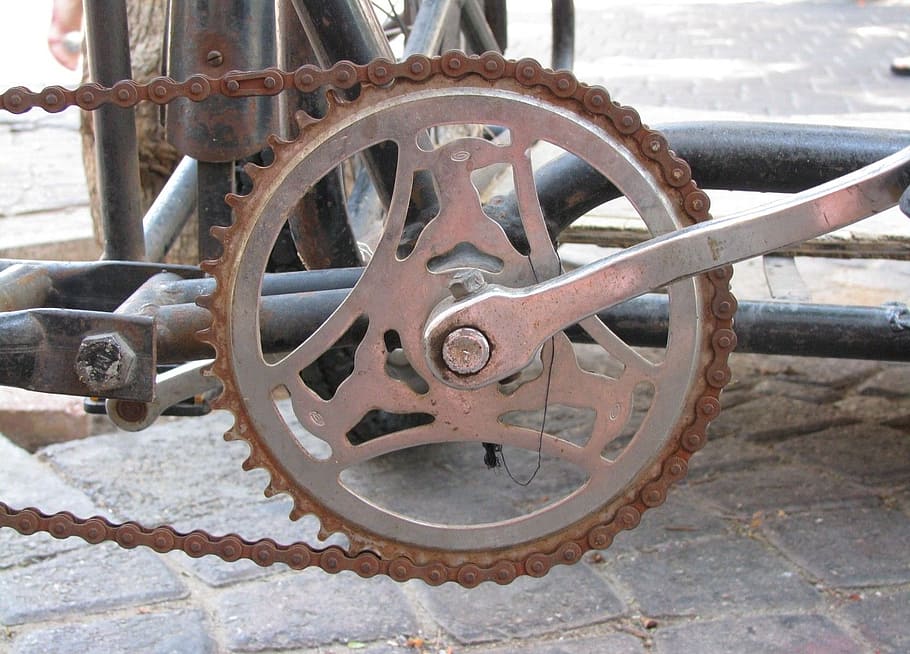
Here’s how to remove rust from a bike chain step-by-step without taking the chain off:
1. Tidy the chain.
The bike chain has to be thoroughly cleaned in the first place. By doing this, you may assist in getting rid of any dirt or debris that can exacerbate the rust.
To clean the chain, use a clean, dry towel to remove any loose dirt or debris.
Using a brush or toothbrush, thoroughly clean the chain, being careful to get into all the nooks and crannies. To assist in loosening any tenacious dirt, apply the degreaser or a light detergent in this step.
Rinse the chain under clean water after washing it, then dab it dry with a clean cloth.
2. Use a Rust Remover or Cleansing Agent

After the chain is thoroughly cleaned and allowed to dry, use a rust remover. There are many of possibilities on the market, but you may also construct your own with common home objects.
A baking soda and water combination is one efficient DIY rust remover.
To prepare this combination, combine the baking soda and water to make a paste, then coat the chain’s corroded sections with the paste.
After letting the paste lie on the chain for ten to fifteen minutes, clean the raised rust off with the brush. Use fresh water to rinse it, then pat it dry one more with a cloth.
3. Use lubricant.
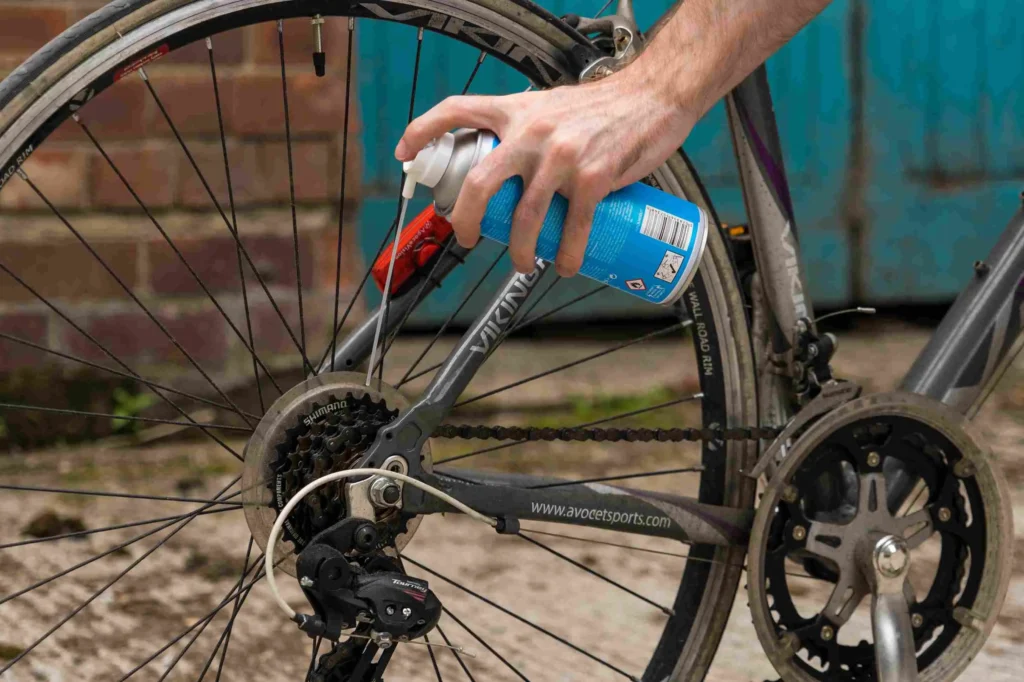
It’s essential to apply lubrication to the chain once the rust has been removed in order to keep it from rusting again and to maintain its smooth operation.
Apply a premium lubricant made specifically for bicycle chains to the chain, being sure to cover every surface.
After that, clean off any leftover lubricant.
Common Mistakes During Rust Removal of Bike Chains
Bike chain rust removal can be a tricky procedure that calls for caution and patience. When cleaning rust from a bike chain, keep in mind these typical errors to avoid:
1. Using Dangerous Substances
Using strong chemicals to remove rust from a bike chain is one of the most common blunders people make.
Although these chemicals might be able to get rid of the rust, they might harm your bike’s metal, which could cause more issues later on.
2. Excessive Cleaning
Scrubbing the rust off your bike chain is essential, but doing so too vigorously might harm the metal. Scrubbing the chain too vigorously might remove its protective coating and increase its susceptibility to rust.
3. Failing to Keep the Chain Lubricated
Further corrosion results from not lubricating the chain. After cleaning the chain, be careful to lubricate it well.
4. Not Guarding Other Elements
Other parts like the brakes and derailleur need to be protected as well. These parts may be harmed by harsh lubricants & cleaning agents.
Before beginning the cleaning procedure, place a plastic bag over the derailleur and any other delicate parts.
5. Taking Off Your Gloves
When using these cleaning solutions, always wear gloves to prevent chemical burns or skin irritation.
FAQ on Removing Rust from Bike Chain
How can I stop the rust from ever starting on my bike chain?
The best defense against chain rust is routine maintenance, lubrication, and cleaning. After rides, clean the chain, lubricate it, and replace any worn chains right away. Bike storage should be done inside; inspect for corrosion.
How often should my bike chain be lubricated?
After it gets wet, or every 100–200 miles, lubricate your chain. Coat the inner and outer chain plates with a thin coating of bike-specific lubricant. Apply lubrication gently as too much would draw grime.
How can I tell if the chain on my bike is rusting?
To detect corrosion, look for rust coloration, stiff links, brown liquid drops, and grinding noises. Moreover, the chain could not move smoothly. Check chains for rust spots on a regular basis.
Is it OK to lubricate my bike chain using WD-40?
No, WD-40 is only meant to be used for cleaning and rust removal. It lacks the lubricating qualities required for bicycle chains. Use only appropriate chain lubricant designed for bicycles.
Is riding a bike with a rusted chain safe?
Rusted chains should ideally be replaced since they can break suddenly. Before riding, at the very least, give the chain a good cleaning and lubrication. However, anticipate lower performance and be ready for any problems.
Conclusion on How to Remove Rust from your Bike Chain?
Although dealing with a rusty bike chain might be difficult, you can get it cleaned up and operating smoothly once more with a little elbow grease and the correct methods. To begin with, carefully examine the chain to determine the position and degree of the rust accumulation.
Examine whether the chain has to be replaced or whether it can be fixed with a thorough cleaning. Next, take off the chain and start using steel wool, scouring pads, and degreasers to combat the rust. Before using brushes to attack it, let it soak so that it penetrates deeper. Continue as necessary until the rust begins to chip off.
Use strong chemicals, such as WD-40, to remove any tenacious deposits. Since moisture is what initially caused the rust, just make sure you lube the chain properly after cleaning.
Although removing a rusty chain by hand might be a rewarding task, you can simply use baking soda and elbow grease to clean the chain directly on the bike. Just stay away from strong chemicals since they may harm the bike.
Bike and chain may be restored to new condition with a little TLC and do-it-yourself rust reduction. Put on some gloves and safety goggles and start cleaning—a smoothly operating chain is waiting!

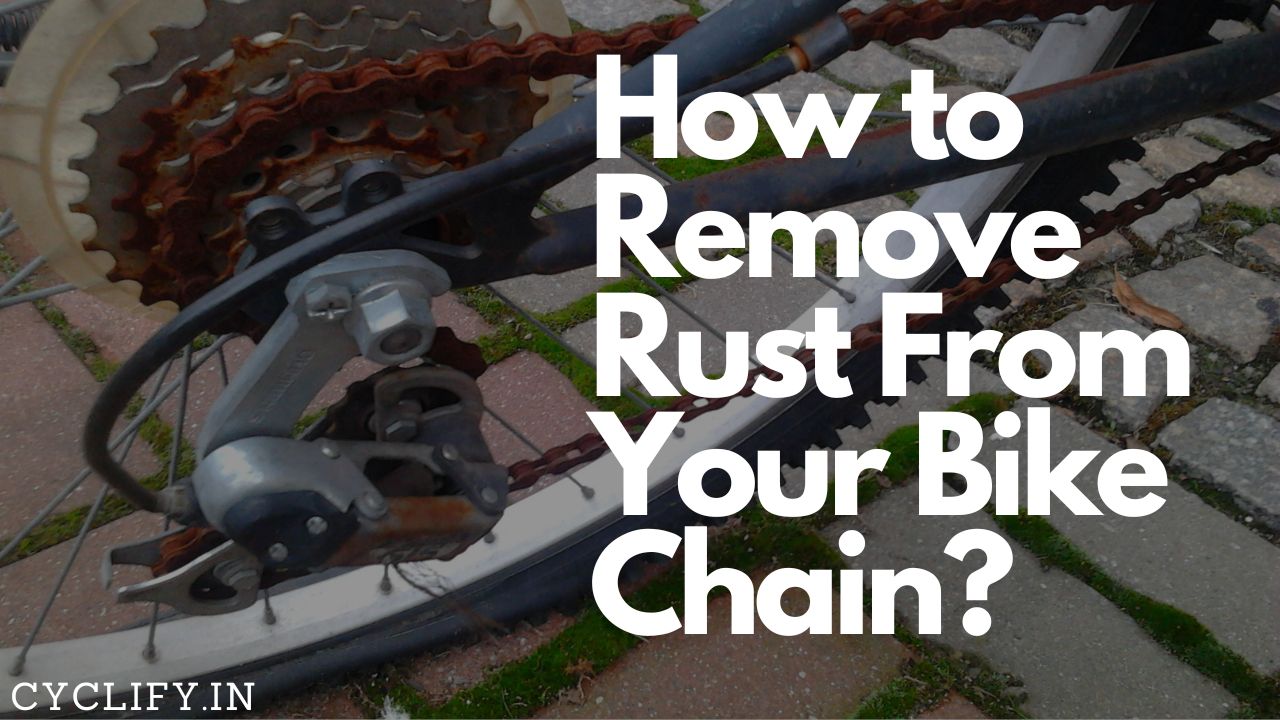
0 Comments